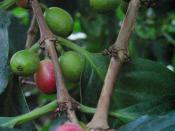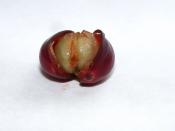Did you know that coffee is the second most actively traded commodity in world? (The first is oil.) Currently seventy different countries produce coffee, the largest being Brazil, and sixty different varieties that are distinguished by origin, flavor and aroma.
There are many different processes that coffee beans must go through before becoming that hot 'cup of Joe' that you drink in the morning on your way to work or on a cold night to warm you up. When evaluating all the process types, it's obvious that coffee processing characterizes that of a "Batch Process". A batch process can be better described as the process used in a bakery or printing shop. Because of the high level of customization required, only small 'batches' can be made at a time.
Coffee processing begins with the mere picking of the ripe cherries from the trees. There are several different ways farmers go about this.
Some use the hand-picking method which is usually the most expensive and selective. Only ripe, high quality berries are picked. Then there is the strip-picking method where pickers strip the entire branch of cherries whether they are ripe or not. While this method is cheaper, it is also associated with lesser quality coffees. Finally, there is mechanical harvesting in which berries are 'shook' from the trees. This takes place on larger plantations. "Because harvesting is so labor-intensive, it's one of the most expensive steps in coffee processing." The beans then go through a wet process or dry process (depending on what flavor is desired), washing, drying, hulling, cleaning, etc.
Many factors need to be considered when estimating the capacity for a coffee processing mill. First and foremost is the constant availability of the product. Since coffee grows exclusively in sub-tropical and tropical regions it's important...


